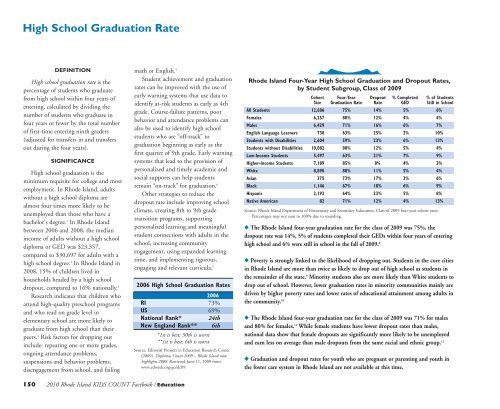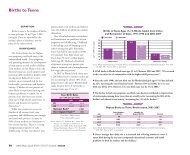2010 Rhode Island Kids Count Factbook
2010 Rhode Island Kids Count Factbook
2010 Rhode Island Kids Count Factbook
Create successful ePaper yourself
Turn your PDF publications into a flip-book with our unique Google optimized e-Paper software.
High School Graduation Rate<br />
DEFINITION<br />
High school graduation rate is the<br />
percentage of students who graduate<br />
from high school within four years of<br />
entering, calculated by dividing the<br />
number of students who graduate in<br />
four years or fewer by the total number<br />
of first-time entering ninth graders<br />
(adjusted for transfers in and transfers<br />
out during the four years).<br />
SIGNIFICANCE<br />
High school graduation is the<br />
minimum requisite for college and most<br />
employment. In <strong>Rhode</strong> <strong>Island</strong>, adults<br />
without a high school diploma are<br />
almost four times more likely to be<br />
unemployed than those who have a<br />
bachelor's degree. 1 In <strong>Rhode</strong> <strong>Island</strong><br />
between 2006 and 2008, the median<br />
income of adults without a high school<br />
diploma or GED was $23,357,<br />
compared to $30,697 for adults with a<br />
high school degree. 2 In <strong>Rhode</strong> <strong>Island</strong> in<br />
2008, 15% of children lived in<br />
households headed by a high school<br />
dropout, compared to 16% nationally. 3<br />
Research indicates that children who<br />
attend high-quality preschool programs<br />
and who read on grade level in<br />
elementary school are more likely to<br />
graduate from high school than their<br />
peers. 4 Risk factors for dropping out<br />
include: repeating one or more grades,<br />
ongoing attendance problems,<br />
suspensions and behavior problems,<br />
disengagement from school, and failing<br />
math or English. 5<br />
Student achievement and graduation<br />
rates can be improved with the use of<br />
early warning systems that use data to<br />
identify at-risk students as early as 4th<br />
grade. Course-failure patterns, poor<br />
behavior and attendance problems can<br />
also be used to identify high school<br />
students who are “off-track” to<br />
graduation beginning as early as the<br />
first quarter of 9th grade. Early warning<br />
systems that lead to the provision of<br />
personalized and timely academic and<br />
social supports can help students<br />
remain “on-track” for graduation. 6<br />
Other strategies to reduce the<br />
dropout rate include improving school<br />
climate, creating 8th to 9th grade<br />
transition programs, supporting<br />
personalized learning and meaningful<br />
student connections with adults in the<br />
school, increasing community<br />
engagement, using expanded learning<br />
time, and implementing rigorous,<br />
engaging and relevant curricula. 7<br />
2006 High School Graduation Rates<br />
2006<br />
RI 73%<br />
US 69%<br />
National Rank* 24th<br />
New England Rank** 6th<br />
*1st is best; 50th is worst<br />
**1st is best; 6th is worst<br />
Source: Editorial Projects in Education Research Center.<br />
(2009). Diplomas <strong>Count</strong> 2009 – <strong>Rhode</strong> <strong>Island</strong> state<br />
highlights 2008. Retrieved June 11, 2009 from<br />
www.edweek.org/go/dc09<br />
<strong>Rhode</strong> <strong>Island</strong> Four-Year High School Graduation and Dropout Rates,<br />
by Student Subgroup, Class of 2009<br />
Cohort Four-Year Dropout % Completed % of Students<br />
Size Graduation Rate Rate GED Still in School<br />
All Students 12,686 75% 14% 5% 6%<br />
Females 6,257 80% 12% 4% 4%<br />
Males 6,429 71% 16% 6% 7%<br />
English Language Learners 738 63% 25% 2% 10%<br />
Students with Disabilities 2,604 59% 23% 6% 13%<br />
Students without Disabilities 10,082 80% 12% 5% 4%<br />
Low-Income Students 5,497 63% 21% 7% 9%<br />
Higher-Income Students 7,189 85% 8% 4% 3%<br />
White 8,890 80% 11% 5% 4%<br />
Asian 375 73% 17% 3% 6%<br />
Black 1,146 67% 18% 6% 9%<br />
Hispanic 2,193 64% 23% 5% 8%<br />
Native American 82 71% 12% 4% 13%<br />
Source: <strong>Rhode</strong> <strong>Island</strong> Department of Elementary and Secondary Education, Class of 2009 four-year cohort rates.<br />
Percentages may not sum to 100% due to rounding.<br />
◆ The <strong>Rhode</strong> <strong>Island</strong> four-year graduation rate for the class of 2009 was 75%, the<br />
dropout rate was 14%, 5% of students completed their GEDs within four years of entering<br />
high school and 6% were still in school in the fall of 2009. 8<br />
◆ Poverty is strongly linked to the likelihood of dropping out. Students in the core cities<br />
in <strong>Rhode</strong> <strong>Island</strong> are more than twice as likely to drop out of high school as students in<br />
the remainder of the state. 9 Minority students also are more likely than White students to<br />
drop out of school. However, lower graduation rates in minority communities mainly are<br />
driven by higher poverty rates and lower rates of educational attainment among adults in<br />
the community. 10<br />
◆ The <strong>Rhode</strong> <strong>Island</strong> four-year graduation rate for the class of 2009 was 71% for males<br />
and 80% for females. 11 While female students have lower dropout rates than males,<br />
national data show that female dropouts are significantly more likely to be unemployed<br />
and earn less on average than male dropouts from the same racial and ethnic group. 12<br />
◆ Graduation and dropout rates for youth who are pregnant or parenting and youth in<br />
the foster care system in <strong>Rhode</strong> <strong>Island</strong> are not available at this time.<br />
150 <strong>2010</strong> <strong>Rhode</strong> <strong>Island</strong> KIDS COUNT <strong>Factbook</strong> / Education






